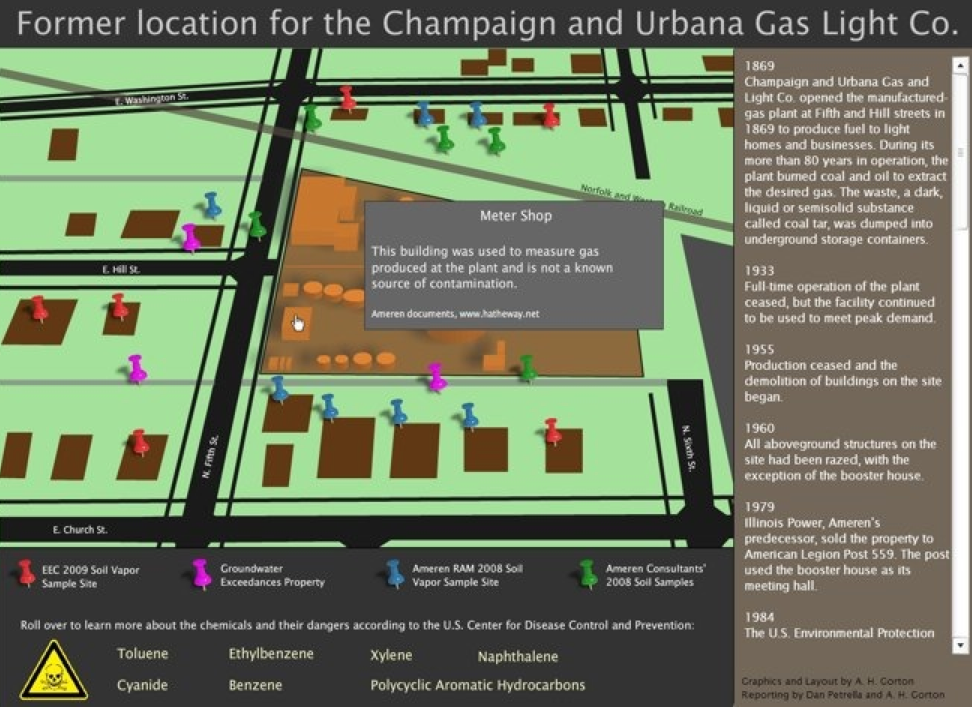OpenGov Voices: Data provides constant revelations for central Illinois communities
Disclaimer: The opinions expressed by the guest blogger and those providing comments are theirs alone and do not reflect the opinions of the Sunlight Foundation or any employee thereof. Sunlight Foundation is not responsible for the accuracy of any of the information within the guest blog.
or any employee thereof. Sunlight Foundation is not responsible for the accuracy of any of the information within the guest blog.
Brant Houston is the Knight Chair in Investigative Reporting at the College of Media at the University of Illinois and Editor in Chief of CU-CitizenAccess — a community online news and information project devoted to investigative and enterprise coverage of social, justice and economic issues in east central Illinois. He can be reached at brant.houston@gmail.com
CU-CitizenAccess.org, an award-winning online newsroom, was launched with public data and it continues to thrive and grow with data about the central Illinois region.
Conceived as a digital platform for university students, faculty and journalism professionals, the project began with a review of basic Census data for the communities of Champaign and Urbana, Illinois in 2008. (Thus, the “C” for Champaign and the “U” for Urbana.) The data revealed what seemed like a surprisingly high percentage of people living in poverty – about 20 percent – in a county that is home to the University of Illinois, a top public educational institution.
But as we scanned the data, we knew there were questions about whether college students, with low earned income, were distorting the numbers. So we looked at the percentage of subsidized school lunches and saw that more than half the school children were receiving lunches. We also read news stories and talked with the staff at the local newspaper and realized there was more than a story to pursue – that there was an ongoing project.
While collecting more data and information, we worked with colleagues to raise funds from a local community foundation, matching money from the Knight Foundation’s Community Information program, and from the University. By the spring 2009, work was underway by Illinois journalism alum Pam Dempsey and Shelley Smithson. In December 2009, the website was up and running and alum Acton Gorton, was helping administer the website while reporting too.

The initial focus on poverty soon expanded to related issues in education, housing, slumlords, migrant worker, neglected neighborhoods, pollution in poor areas, and criminal justice. Then it moved into even broader investigative and enterprise stories.
With each inquiry there is an emphasis on data and visualizing it with charts, maps, and other graphics. One story detailed the deterioration of a neighborhood caused by a bizarre rezoning of a residential area into industrial over time, during which time residents could not repair or rebuild their houses as the houses aged. The reporters obtained a property database for the neighborhood, then took photos of the increasing number of industrial buildings, and created an interactive map that allowed a user to cursor over properties and see data and photos at the same time.
Another story was on pollution from a closed manufacturing gas facility. Such facilities provided light and heat for communities in the first third of the 20th century by burning coal at high temperatures. In that story, reporters used property records and pollution records to show where toxic chemicals appeared in the neighborhood. Sometimes, reporters put together quick infographics on topics such as unemployment with, or without, stories.
The idea for CU-CitizenAccess.org is that it is not only a multi-media, multi-platform newsroom, but also a class and teaching laboratory for trying out and integrating new digital techniques into journalism – at a time of dramatic transformation in the profession. In addition to using mapping (geographical information systems) and other common data visualizations, we are also experimenting with text-mining. We use DocumentCloud, a basic text-mining tool developed with a Knight Foundation grant, and now run by Investigative Reporters and Editors.
But we also are experimenting with Natural Processing Language techniques, including topic modeling, which is a way of looking for and visualizing patterns in text. To do this, we work with computer programmers from the National Center for Supercomputing Applications (where the first commercial Web browser, Mosaic, was developed) and with faculty at the Graduate School of Library and Information Science and at the Illinois Informatics Institute.
Since its early days, CU-CitizenAccess.org has developed into a public service journalism site, providing stories, data, and visuals on neglected property, struggling school systems, flawed bridges, nursing home inspections, and jails. One major success has been the use of restaurant inspection reports and data. The public health district does not make the reports easily available. In fact, we have to file Freedom of Information requests for copies of the actual reports.
We take the reports of the failed restaurants and link them to an interactive map. By clicking on the particular restaurant on the map, a citizen can go to the actual report, which is posted on our website and read through it. Tens of thousands of unique viewers visit the inspection reports each year and we plan to add more tools in the coming year to help them judge the safety of the food they eat.
But CU-CitizenAccess.org also is a collaborator and content provider to local media, including the region’s newspaper, the News-Gazette, and Illinois Public Media, which is the region’s NPR and PBS stations. It also has won awards for its work with Hoy Chicago, the Spanish language newspaper and online news site of the Chicago Tribune.
In an ambitious, half year project with Hoy Chicago, CU-CitizenAccess.org went very data heavy, using Census data and arrest data to track and visualize the changing demographics and racial disparities in criminal justice in east Central Illinois. The project was a bi-lingual combination of websites, a special section in newspapers, and reports aired on public radio.
While we have accomplished much, we have much more data to mine and many more digital stories to tell.
Interested in writing a guest blog for Sunlight? Email us at guestblog@sunlightfoundation.com.

